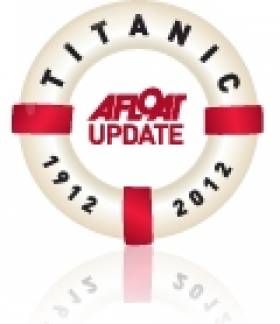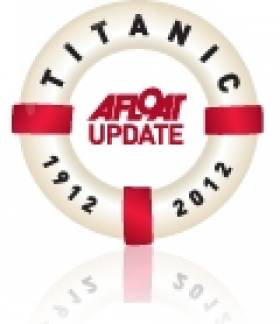Displaying items by tag: ocean liner
#TITANIC - A Belfast man who saw the Titanic launch from the Harland and Wolff shipyards more than 100 years ago was guest of honour at the opening of Titanic Belfast at the weekend.
"It's like our Sydney Opera House," 105-year-old Cyril Quigley told BBC News of the £97 million (€116.7 million) visitor centre, opened on the 100th anniversary of the infamous ocean liner's tragic demise.
"My father and mother took me to Workman and Clark shipyard which is on the opposite side [of Belfast Lough] to watch the launch," he recalled to the Belfast Telegraph.
"I just saw a mass of metal in the gantries that they built for it and all I saw was this big thing sliding out into the water. I was only four-and-a-half."
Quigley described the new facility - designed to echo the imposing bow of the Titanic - as "wonderful", a sentiment echoed by Belfast Lord Mayor Niall O'Donnghaile who said: "The Titanic belongs to Belfast but this spectacle - Titanic Belfast - belongs to the world."
First Minister Peter Robinson was joined by Deputy First Minister Martin McGuinness at the ribbon cutting ceremony on Saturday 31 March, with the former declaring that this is "a new era in this province".
Titanic Belfast is expected to attract more than 400,000 visitors in its first year, and some 100,000 people have already purchased tickets. It will also be one of the largest employers and recruiters in Northern Ireland's tourism industry, as previously reported on Afloat.ie.
But the public's reaction so far has been mixed, according to The Irish Times, with some expressing disappointment at the lack of any large-scale model of the ship, and that the replica of the ship's famous staircase is hidden from public view in the venue's banqueting hall.
Plaque Honours Famous Playwright and Titanic Orphan
#TITANIC - A plaque honouring Titanic orphan and playwright William Ruddick Millar has been unveiled in his hometown of Carrickfergus, the News Letter reports.
Millar was orphaned at five years old when his father, a deck engineer on the ill-fated ocean liner, went down with the ship after it struck an iceberg on 15 April 1912.
He faced a difficult childhood, he and his brother Thomas joining their eight cousins under the care of a great aunt.
But by the age of 18 he had already seen one of his plays performed at the Grand Opera House in Belfast.
In the decades after he became a renowned author famous for titles such as Stirabout, When Johnny Comes Marching Home and The Land Girl. He also wrote for radio as well as books and newspaper articles.
Great-granddaughter Susie Millar was on hand for the unveiling at the cottage where he was raised by his great aunt. “Our entire family are so proud to have him remembered in this way," she said.
The News Letter has much more on the story HERE.






























































